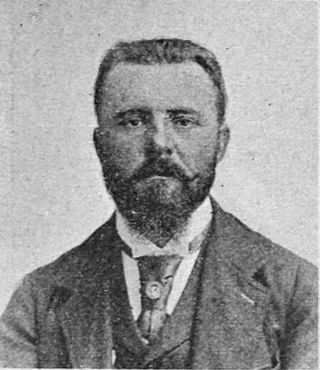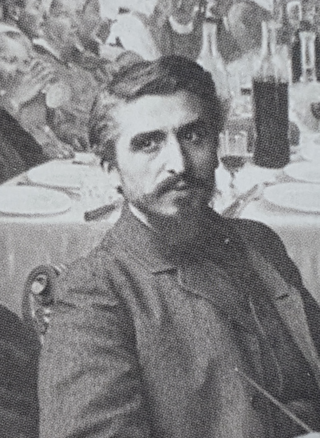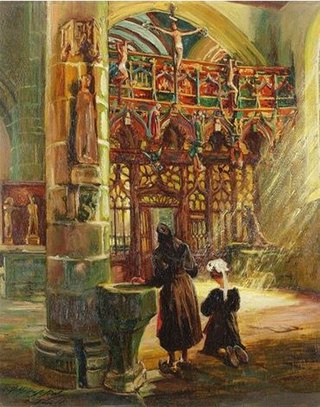This article needs additional citations for verification .(August 2014) |

Alfred Guillou (12 September 1844, Concarneau - 1926, Concarneau) was a French painter of Breton heritage.
This article needs additional citations for verification .(August 2014) |

Alfred Guillou (12 September 1844, Concarneau - 1926, Concarneau) was a French painter of Breton heritage.
His father was a fisherman and farmer who served as mayor of Concarneau for fifteen years. [1] He received his first art lessons from the lithographer Théodore Le Monnier (1815–1888), who was visiting Concarneau. On his advice, Guillou moved to Paris in 1862, where he attended the Académie Suisse for a short time, then found a position in the workshop of Alexandre Cabanel. [1] While there, he met Jules Bastien-Lepage, Fernand Cormon and Théophile Deyrolle, who he convinced to give up architecture and join him at Cabanel's.
He debuted at the Salon in 1868 with his Young Breton Fisherman. Three years later, he and his friend Deyrolle left Paris for Concarneau, with nothing more than they could carry on their backs. The following year, Deyrolle married Guillou's sister Suzanne (1846-1933), who was also a painter. Together, they created the Concarneau Art Colony, which benefitted from its proximity to Pont-Aven, where Paul Gauguin and his followers congregated. He also exhibited works at both the 1889 and 1900 Universal Exhibitions in Paris where he received silver medals. [2]

After his marriage to the daughter of the engraver Joseph Gabriel Tourny (1817–1880), he maintained a home in Montparnasse, but spent as much time as possible in his hometown. Following his father's death in 1887, he built a home and workshop there, became involved in local politics and joined the board of the Musée des beaux-arts de Quimper. [1]
Over the years, the Colony attracted many artists who were either interested in maritime subjects or wanted to achieve a sort of primitivism; represented for them by the traditions of the Breton people, which had survived mostly intact from an earlier period. Among the better-known artists who spent time there were Peder Severin Krøyer, Charles Cottet, Jules Bastien-Lepage, Pascal Dagnan-Bouveret, Amélie Lundahl, Cecilia Beaux and T. Alexander Harrison.
Henri Alphonse Barnoin was a French painter born in Paris in 1882.
René-Yves Creston, born René Pierre Joseph Creston, was a Breton artist, designer and ethnographer who founded the Breton nationalist art movement Seiz Breur. During World War II he was active in the French Resistance.
Émile Jean Armel-Beaufils was a French sculptor born in Rennes in 1882 and who died in Saint-Briac in 1952.

Jean-Eugène Buland was a French painter.

Joseph-Félix Bouchor was a French painter noted for his portraits and his Orientalist themes.

Charles Filiger was a French Symbolist painter. He was one of the artists who associated with Gauguin at Pont-Aven in Brittany.

Théophile-Louis Deyrolle was a French painter, illustrator and ceramicist.

Henri Guinier was a French portrait and landscape painter.
Lionel Floch was born in Quimper in 1895 and died in 1972. He was a French painter, engraver, and designer.

Jean-Édouard Dargent, known as Yan' Dargent and in his later years Yann Dargent, was born in Saint-Servais on 15 October 1824 and died in Paris on 19 November 1899. He was a French painter and illustrator. Most of his paintings depicted Brittany.
Jean-Baptiste Jules Trayer was a French painter. He signed his works "Jules Trayer".

Henry d'Estienne was a French painter and a member of the Académie des Beaux-Arts.
Germain David-Nillet who was a French painter. He was born on 4 December 1861 in Paris and died on 12 October 1932 in Paris.

Arthur Midy was a French landscape and genre painter.
Alfred Beau was a French painter, ceramicist and photographer.
Charles Léon Godeby, was a French painter who painted scenes in Brittany and North Africa.

Achille Granchi-Taylor was a French painter and illustrator.

René Quéré was a French painter, illustrator, ceramist, and teacher.
Pierre Abadie, also known as Pierre Abadie-Landel, was a French painter, wood engraver, and ceramicist.